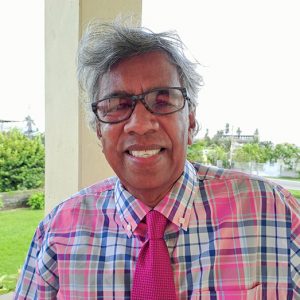I LISTENED for one hour as Vincent Alexander last week on the Freddie Kissoon Show described the post slavery trauma (PST) that African Guyanese live with, and according to Alexander, with time, it has passed into the genetic make-up of African Guyanese. Logically, then, the condition is permanent.
Research will reveal that Alexander borrowed entirely from the theory which originated from some African-American academics. The first attempt to discuss how one of the two transplanted ethnic groups, East Indians, into British Guiana suffered from a social aberration found in India was Kean Gibson.
Ms. Gibson argued that the Hindu population in Guyana believes and practices the caste system. Her book was a mere 73 pages, devoid of research. Repeating my arguments against her theory, which I did in 2003, may take up too much space. I described Ms. Gibson’s book as propaganda simply because it was more of a political tract rather than a research manuscript.
Hindus were incapable of practising the caste system because the colonial state’s cultural contempt for them, the relentless ostracisation from the Mulatto Creole class and Burnham’s totalitarianism forced them to seek solidarity among themselves including socialisation with Muslim Indians. It would have been a contribution to Guyana’s historiography if Ms. Gibson had used class instead of caste to understand the Hindu population.
The landed Indian stratum and the Christian Indians constituted an Indian petite bourgeoisie that snubbed their fellow Indians out of class prejudice rather than caste preference, a situation which still obtains today but was diluted considerably under the PPP while both in power from 1957 to 1964 and in opposition from 1964 onwards. The nature of leadership of Indians under Cheddi Jagan created an enduring class consciousness that did not leave room for Indians to reproduce the caste system.
It is outside the scope of a newspaper column to guillotine the wild theory of a post-slavery trauma in Guyana. The condition was applied to the US where the post-slavery world of Afro-Americans had absolutely nothing in common with post-slavery society in British Guiana (BG), emphasis on the adverb, absolutely.
In the US, long after slavery, Africans had no breathing space for anything. They were relentlessly repressed, denied opportunities in totality and were victims of wanton police killings and white supremacist violence like the Klux Klax Klan. It was natural then to see the emergence of trauma and psychological syndromes.
In British Guiana, Africans became the aggressors rather than victims. The emancipated house slaves – Mulatto Creole class (MCC) were just a peg below the colonial whites and because of race and religion chose to offer opportunities to the emancipated field slaves despite their dark skins. What you had then was a combination of colonial administrators, MCC and the new urban Black proletariat as oppressors against the former Indentured labourers.
Even a trade unionist like Critchlow voted to deny the Indians the franchise. To survive, the Indians found four types of refuges. One, they found solace in Hinduism and Islam and the formation of Indian organisations. Two, they gave their children Christian names to wrest recognition from the colonial administrators. Three, they sought to educate their children. Four, politics was the way of fighting back.
This combination of colonial administrators, MCC and Black proletariat reached its zenith in the Forbes Burnham cult. Burnham became coterminous with Guyana. Ironic that the same White imperial society and White state in the US that caused the birth of the post-slavery trauma and were oppressing Afro-Americans were in fact liberating Afro-Guyanese through systemic violence against Indians and their party, the PPP.
From 1964 to 1992, through imperialist designs, Burnham (who died in 1985) and his Afro-centric PNC organisation dominated Guyana to the point where the rural Indian peasantry, the landed Indian stratum, the Indian professional class and the small, Indian petite bourgeoisie exited Guyana en masse.
From the time of emancipation to the end of PNC’s rule, there was no psychological manure in which post-slavery trauma could have grown in British Guiana and Guyana. This is why I used the adverb “absolutely” in arguing that there was no similarity between emancipated US and emancipated Guyana.
If there was a fertile soul for a trauma to have emerged in this country, then it could have been the “post-Burnham trauma” among Indian Guyanese, including the oppressed Indian peasantry and the small urban Indian proletariat who could migrate and had to stay and also the Indian diaspora who were reeling from displacement.
These categories of people were susceptible to a post-Burnham trauma, given what Burnham did to them, and it must be noted, Vincent Alexander was the youth leader of the PNC under Burnham. So, is there a post-slavery trauma in Afro-Guyana and a post-Burnham trauma in Indo-Guyanese? The answer is yes. In the comic books.
DISCLAIMER: The views and opinions expressed in this column are solely those of the author and do not necessarily reflect the official policy or position of the Guyana National Newspapers Limited.



.jpg)








